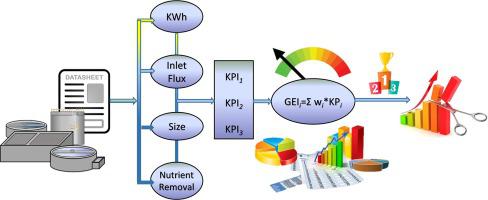当前位置:
X-MOL 学术
›
Energy Convers. Manag.
›
论文详情
Our official English website, www.x-mol.net, welcomes your
feedback! (Note: you will need to create a separate account there.)
Energy saving in wastewater treatment plants: A methodology based on common key performance indicators for the evaluation of plant energy performance, classification and benchmarking
Energy Conversion and Management ( IF 9.9 ) Pub Date : 2020-09-01 , DOI: 10.1016/j.enconman.2020.113067 G. Sabia , L. Petta , F. Avolio , E. Caporossi
Energy Conversion and Management ( IF 9.9 ) Pub Date : 2020-09-01 , DOI: 10.1016/j.enconman.2020.113067 G. Sabia , L. Petta , F. Avolio , E. Caporossi

|
Abstract Wastewater treatment plants are a major energy user in the urban water cycle with an energy demand estimated in several countries in about the 1% of the overall national energy use. Nevertheless, the sector offers wide opportunities for energy saving and recovery to be fostered in order to reduce economic and environmental impacts. Nowadays, a consolidated procedure to assess energy performances in the wastewater sector is still not available. This work proposes a methodology for the evaluation, benchmarking and labelling of energy performances of wastewater treatment plants, based on easy-to-define data related to energy use and operative parameters. Statistical techniques are applied to validate input data and the step-by-step derived outcomes. Common key performance indicators were calculated and linearly aggregated in a global index able to convey the wastewater treatment plant energy performance. Such index allowed to carry out comparisons among energy consumptions supported by a dedicated built-up database collecting sectorial data, considered as a reference. A case study based on 10 selected wastewater treatment plants is proposed. The methodology led to derive a clear and affordable overview of the analysed plant energy performances. Moreover, the benchmarking analysis allowed to get, on the basis of the differences between the calculated global index values, a rough estimation of the potential energy gains achievable if suitable measures for ameliorating the plant energy efficiency performance are adopted. For three of the selected plants, the margins for energy savings resulted higher than 60%. The methodology suggests to focus on such cases by carrying out specific on-site inspection to detect energy use inefficiencies and define suitable actions addressed to save energy and enhance the system sustainability. In this view, the proposed procedure could also be applied with the aim of prioritizing actions to pursue energy savings among a large set of wastewater treatment plants.
中文翻译:

污水处理厂节能:一种基于共同关键绩效指标的方法,用于评估工厂能源绩效、分类和对标
摘要 污水处理厂是城市水循环中的主要能源用户,估计几个国家的能源需求约占全国能源使用总量的 1%。尽管如此,该部门为促进节能和恢复提供了广泛的机会,以减少对经济和环境的影响。如今,仍然没有一个综合程序来评估废水部门的能源绩效。这项工作基于与能源使用和操作参数相关的易于定义的数据,提出了一种评估、基准和标记废水处理厂能源性能的方法。应用统计技术来验证输入数据和逐步导出的结果。通用的关键绩效指标被计算并线性汇总到一个能够传达污水处理厂能源绩效的全球指数中。这样的指数允许在收集部门数据的专用内置数据库支持的能源消耗之间进行比较,被视为参考。建议基于 10 个选定的污水处理厂进行案例研究。该方法导致对所分析的工厂能源性能进行清晰且经济实惠的概述。此外,基准分析允许根据计算出的全球指标值之间的差异,粗略估计如果采用适当的措施来改善工厂能效绩效,则可以获得的潜在能源收益。对于三个选定的植物,节能利润率高于 60%。该方法建议通过进行特定的现场检查来检测能源使用效率低下的情况,并确定合适的行动以节省能源并提高系统可持续性,从而关注此类情况。从这个角度来看,提议的程序也可以用于在大量污水处理厂中优先采取行动以实现节能。
更新日期:2020-09-01
中文翻译:

污水处理厂节能:一种基于共同关键绩效指标的方法,用于评估工厂能源绩效、分类和对标
摘要 污水处理厂是城市水循环中的主要能源用户,估计几个国家的能源需求约占全国能源使用总量的 1%。尽管如此,该部门为促进节能和恢复提供了广泛的机会,以减少对经济和环境的影响。如今,仍然没有一个综合程序来评估废水部门的能源绩效。这项工作基于与能源使用和操作参数相关的易于定义的数据,提出了一种评估、基准和标记废水处理厂能源性能的方法。应用统计技术来验证输入数据和逐步导出的结果。通用的关键绩效指标被计算并线性汇总到一个能够传达污水处理厂能源绩效的全球指数中。这样的指数允许在收集部门数据的专用内置数据库支持的能源消耗之间进行比较,被视为参考。建议基于 10 个选定的污水处理厂进行案例研究。该方法导致对所分析的工厂能源性能进行清晰且经济实惠的概述。此外,基准分析允许根据计算出的全球指标值之间的差异,粗略估计如果采用适当的措施来改善工厂能效绩效,则可以获得的潜在能源收益。对于三个选定的植物,节能利润率高于 60%。该方法建议通过进行特定的现场检查来检测能源使用效率低下的情况,并确定合适的行动以节省能源并提高系统可持续性,从而关注此类情况。从这个角度来看,提议的程序也可以用于在大量污水处理厂中优先采取行动以实现节能。











































 京公网安备 11010802027423号
京公网安备 11010802027423号